The Ant Nebula is a bipolar planetary nebula located approximately 8,000 light-years away in the southern constellation Norma. It has an apparent magnitude of 13.8 and an apparent size of over 50 by 12 arcseconds. The nebula’s name comes from its resemblance to the head and body of an ant when seen in ground-based telescopes.
The nebula is also known by its catalogue designations Menzel 3 (Mz 3) and ESO 225-9. The nebula’s structure, colourful appearance and spectrum have earned it the nickname the “Chamber of Horrors” of planetary nebulae.
Like all planetary nebulae, the Ant Nebula is composed of dust, hydrogen, helium and other gases that form an intricate structure that conceals the central progenitor star.
The interstellar cloud of dust formed when a low- to intermediate-mass star reached the end of its evolutionary cycle and cast off its outer layers of gas into space. The ejected material forms the nebula while the stellar remnant, a hot white dwarf, provides the ionizing photons that make the nebula glow.
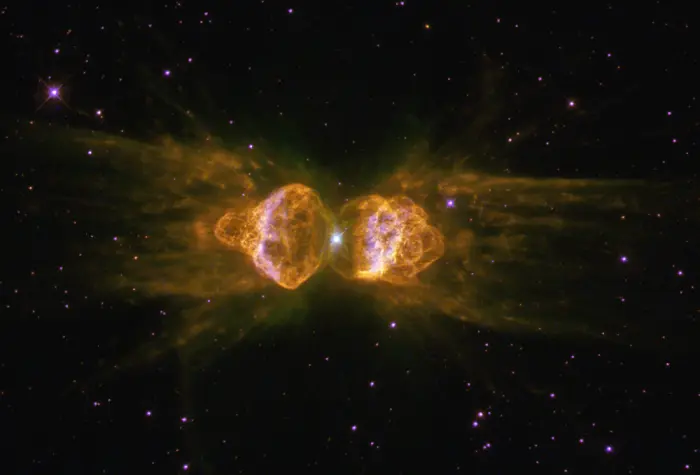
Ant Nebula, image credit: Judy Schmidt (CC BY 2.0)
Planetary nebulae are the last stages in the lives of stars that are not massive enough to go out as supernovae. The Ant Nebula shows our Sun’s fate in about 5-6 billion years. It is radially expanding with a velocity of about 50 km/s.
The young planetary nebula has a bright core and four spherical high-velocity outflows: lobes, columns, rays, and chakram. The bipolar lobes have different morphologies but share a common axis of symmetry. Both the lobes and the outer large filamentary nebulosities have been extensively studied.
Studies published in 2002 and 2006 suggest that the planetary nebula nucleus contains a symbiotic Mira variable. A white dwarf ionizes the nebula, and the giant binary companion gives rise to such dense gas in the nebula’s central region.
The nebula may have evolved similarly to the better-known Twin Jet Nebula (M2-9, Minkowski’s Butterfly) in the constellation Ophiuchus. However, the outflow speeds in the Ant Nebula are up to 10 times higher than those in the Twin Jet Nebula. A similar outflow pattern has been observed in the luminous blue variable Eta Carinae, located in the vast Carina Nebula in the constellation Carina.
The chakram is the most unusual feature in the Ant Nebula. The large, faint limb brightened ellipse was discovered in 2004 in images obtained with the Hubble Space Telescope and the ESO New Technology Telescope (NTT). The same study proposed a time sequence of the ejection of the different outflows, saying that the rays were ejected first, then the columns, and finally the lobes. However, the study authors noted that some of the outflows may have occurred at the same time.
The chakram lies near the reflection symmetry plane of the nebula’s other features but is offset from it. The radially expanding outflow has an expansion pattern that, unlike the nebula’s lobes, columns and rays, does not follow a Hubble law. It has its centre on the planetary nebula’s nucleus and shows radial motion with no increase in velocity as the radial offset from the nebula’s core increases. This feature is believed to be associated with the evolution of the central star.
Observations with the European Space Agency’s (ESA) Herschel Space Observatory provided a different insight into the nebula’s structure than visible images taken with NASA and ESA’s Hubble Space Telescope, revealing intense laser emission from the nebula’s core. The unusual laser emission detected during the Herschel observations indicates the presence of a double star system in the nebula’s centre.
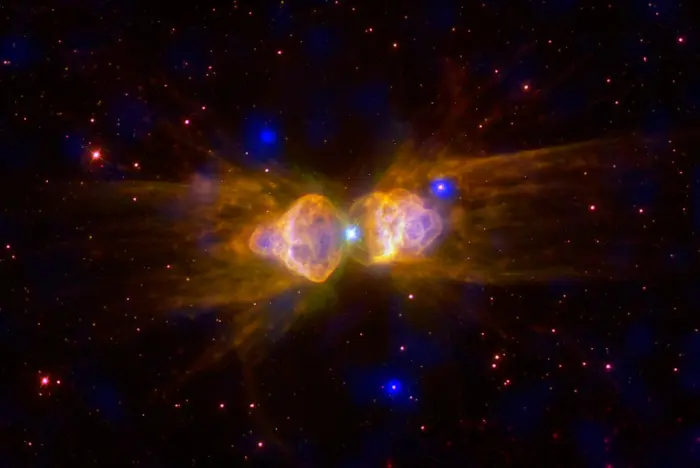
Planetary nebulas – so called because some of them resemble a planet when viewed through a small telescope – are produced in the late stages of a Sun-like star’s life. This image shows Chandra’s view of Menzel 3 (Mz3, also known as the Ant Nebula). Dynamic elongated clouds envelop bubbles of multimillion degree gas produced by high-velocity winds from central stars. Image credit: Smithsonian Institution; X-ray: NASA/CXC/RIT/J.Kastner et al.
A study led by astrophysicist Isabel Aleman of the Leiden Observatory in the Netherlands suggested that this kind of emission – hydrogen recombination line laser emission – required the presence of very dense gas close to the central star. The laser signal in the core of the nebula enhances the observed hydrogen recombination laser emission.
The density of the gas at the heart of the Ant Nebula is about ten thousand times higher than that detected in typical planetary nebulae, as well as in the twin lobes of the Ant Nebula. The gas is believed to be orbiting around the star in a dense disc. This suggests that the white dwarf star has a companion that deflects the ejected gas into orbit.
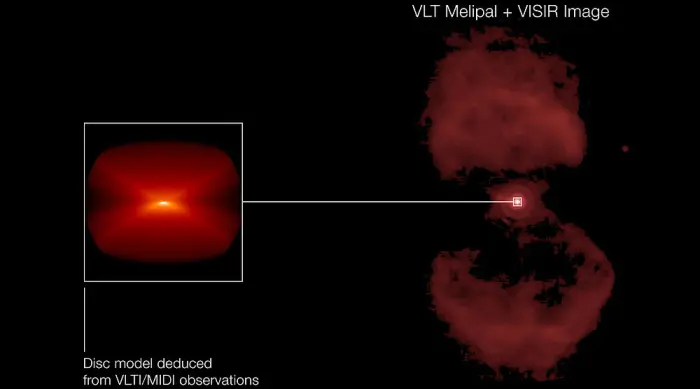
Using ESO’s Very Large Telescope Interferometer, astronomers have uncovered a disc in the heart of the Ant Nebula. The disc seems, however, too ‘skinny’ to explain how the nebula got its intriguing ant-like shape. The image on the right shows a previously taken image of the Ant Nebula, in the mid-infrared, with the VLT Imager and Spectrometer for the mid-InfraRed (VISIR). The image on the left shows a model of the dusty disc the astronomers uncovered with the MID-infrared Interferometric instrument (MIDI), which combined the light from two 8.2-m VLT Unit Telescopes. The lower part of the image representing the southern lobe is brighter, for this lobe is closer to our line-of-sight. The major axis of the flat, nearly edge-on disc is perpendicular to the axis of the bipolar lobes of the nebula. The disc extends from about 9 times the mean distance between the Earth and the Sun (9 Astronomical Units or 9 AU) to more than 500 AU. Image credit: ESO (CC BY 4.0)
The companion is believed to be an evolved star that is losing mass, which is then captured by the compact white dwarf, producing the disc. The presence of a binary system at the core of the Ant Nebula is not only responsible for the nebula’s complex shapes, but also its chemical properties.
The Herschel Planetary Nebula Survey (HerPlaNS) was conducted by an international team of astronomers from the Leiden Observatory in the Netherlands, the University of Denver and the Smithsonian Astrophysical Observatory in the United States, the Jodrell Bank Centre for Astrophysics at the University of Manchester in the United Kingdom, the University of São Paulo in Brazil, the Royal Observatory of Belgium, the University of Bonn, Germany, the Autonomous University of Madrid in Spain, and the Institute of Astronomy and Astrophysics in Taiwan. It was published in the Monthly Notices of the Royal Astronomical Society in 2018.
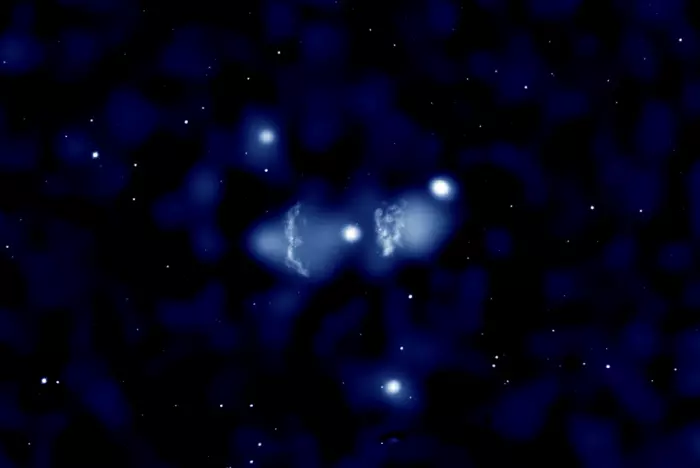
An X-ray image of the Ant Nebula captured by the Chandra X-ray observatory, image credit: NASA
Facts
The Ant Nebula was discovered by American astronomer Donald Menzel in 1922. Menzel reported his discovery in the Harvard Bulletin, Vol. 777. He discovered the planetary nebulae Menzel 1 (ESO 135-11) and Menzel 2 (ESO 178-15) at the same time. All three nebulae are located in the constellation Norma.
Interestingly, Menzel was the first to propose that lasers could occur in nebulae, long before the discovery of lasers in laboratories. (The first laser was built by American physicist and engineer Theodore Maiman in 1960). Menzel suggested that natural “light amplification by stimulated emission of radiation” (acronym for “laser”) may occur in nebulae in certain conditions.
The Ant Nebula was first imaged by the Hubble Space Telescope (HST) on July 20, 1997, and June 30, 1998. The image was captured by Hubble’s Wide Field and Planetary Camera 2. It revealed the nebula’s pair of fiery lobes and symmetrical patterns in the material ejected from the central star. At the time, the data obtained with Hubble challenged old ideas about the formation of planetary nebulae.
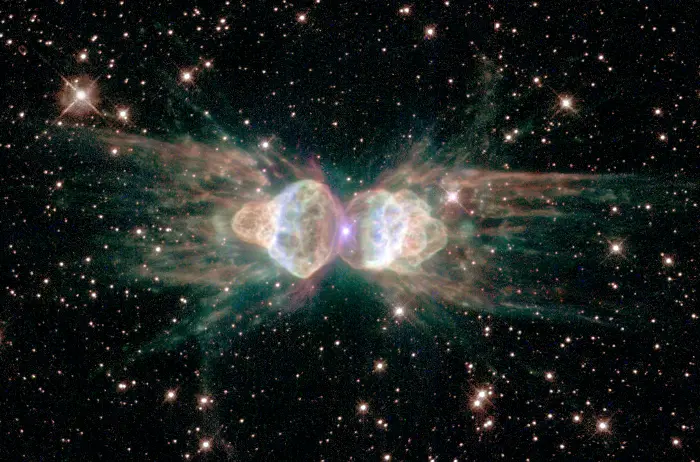
This NASA/ESA Hubble Space Telescope image reveals the ant’s body as a pair of fiery lobes protruding from a Sun-like star that reached the end of its life. The ejection of gas from the star at the center of Mz3 has intriguing symmetrical patterns unlike the chaotic patterns expected from an ordinary outburst. Scientists using the Hubble Space Telescope would like to understand how a spherical star can produce such prominent, non-spherical symmetries in the gas that it ejects. One possibility is that the central star of Mz3 has a closely orbiting companion that exerts strong gravitational tidal forces, which shape the outflowing gas. For this to work, the orbiting companion star would have to be close to the central star, about the distance of the Earth from the Sun. At that distance the orbiting companion star wouldn’t be far outside the hugely bloated hulk of the central star. It’s even possible that the central star has consumed its companion, which now orbits inside of it, much like the duck in the wolf’s belly in the story “Peter and the Wolf.” A second possibility is that, as the central star spins, its strong magnetic fields are wound up into complex shapes. Charged winds moving at speeds up to 1000 kilometers per second from the star, are able to follow the twisted field lines on their way out into space. These dense winds can be rendered visible by ultraviolet light from the hot central star or from highly supersonic collisions with the ambient gas that excites the material into florescence. Astronomers Bruce Balick (University of Washington) and Vincent Icke (Leiden University) used Hubble to observe this planetary nebula, Mz3, in July 1997 with the Wide Field Planetary 2 camera. One year later, astronomers Raghvendra Sahai and John Trauger of the Jet Propulsion Lab in California snapped pictures of Mz3 using slightly different filters. This intriguing image, which is a composite of several filters from each of the two datasets, was created by the Hubble Heritage Team. Image credit: NASA, ESA & the Hubble Heritage Team (STScI/AURA); acknowledgment: R. Sahai (Jet Propulsion Lab), B. Balick (University of Washington)
Location
The Ant Nebula appears about a third of the way from Gamma2 to Kappa Normae. The class K giant Gamma2 Normae is the brightest star in Norma, but shining at magnitude 4.02, it is a challenging target from light-polluted areas. Kappa Normae is even fainter at magnitude 4.95. The bright stars of Scorpius and Centaurus can be used for orientation.
The nebula lies roughly halfway between the bright Shaula (Lambda Scorpii) at the Scorpion’s stinger and Rigil Kentaurus (Alpha Centauri) at the foot of Centaurus. The celestial Ant can be found at the point where the imaginary line from Shaula to Rigil Kentaurus intersects with the one connecting Atria, the brightest star in Triangulum Australe, and Fang, the southernmost bright star in the Scorpion’s claws.
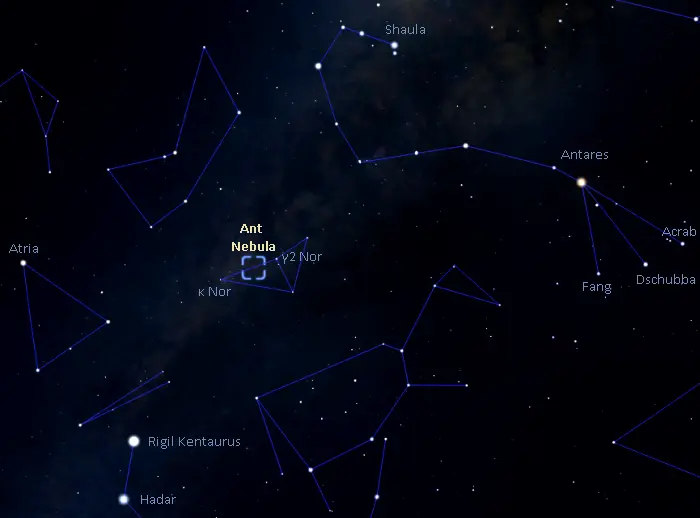
The location of the Ant Nebula (Menzel 3), image: Stellariun
The best time of the year to observe the Ant Nebula and other deep sky objects in Norma is during the month of July, when the constellation is higher above the horizon in the evening. At declination 52° S, the Ant Nebula never rises for observers north of the latitude 38° N, and it never appears high above the horizon for northern observers in equatorial latitudes.
Ant Nebula – Mz 3
| Constellation | Norma |
| Right ascension | 16h 17m 13.3915382496s |
| Declination | −51° 59′ 10.711893480″ |
| Apparent magnitude | 13.8 |
| Absolute magnitude | 1.8 |
| Apparent size | >50″ × 12″ |
| Distance | 8,000 light-years (2,500 parsecs) |
| Radius | 1 light-year |
| Names and designations | Ant Nebula, Menzel 3 (Mz 3), Chamber of Horrors, ESO 225-9, Henize 2-154 (Hen 2-154), VV’ 136, VV 80, RCW 101, WRAY 16-213, PN G331.7-01.0, Gaia DR2 5934701559547878144, Gaia DR3 5934701559547878144 |